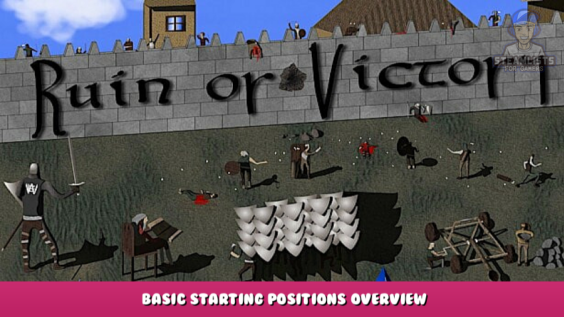
Welcome to Ruin or Victory – Basic Starting Positions Overview Guide.
This guide contains a basic analysis and overview of the six starting positions for the player.
Basic
Structures: One house, one stockpile (() with a few goodies ()).
Initial units: Four peasants, one carrying a sickle and one an axe. One a pick.
No initial technologies
Initial Moves: Create a stone crafting workshop using 3 starter units; then build a house with the fourth unit.
Nomad
No initial structures
Four peasants: One with a sickle, another with an axe, and one with a pick
One warrior riding on a horse with bows and arrows
Small cart
Large cart pulled by horse and ox.
Initial technologies: Large Cart, Hand Cart, and Animal Domestication (Pasture
Flexiblest of all starting builds
Two peasants should be assigned to drive the carts. If necessary, you can move to a better location. Wild animals can attack the caravan.
Detach all units from the large cart and unpack it. Set its stockpile, armory and other resources to accept all items and resources. Before you start the scenario, make sure that the option Carts starts permitting all is True. This will save you several clicks.
One peasant and one small cart are assigned to build two houses. With the remaining units, build a stone crafting workshop.
In the first 12 minutes of a scenario, a player could have researched and baked clay, hand cart and pasture. After that, it’s just about choosing a strategy for animal domestication and managing gatherers and other resources. Two gatherers are needed to jump-start wood gathering.
Use your ox to transport materials to a building site.
Fortified
The starting town is the square or circular wooden fort that surrounds a house and a stockpile.
Four peasants: One with a sickle, another with an axe, and one with a pick
Initial technology is Wood Wall
This is the best starting build. You can safely place 6-8 range units along the walls, facing the enemy. Wood Wall technology can be used to create defensive structures if the player expands beyond the fort’s walls.
Towers
The starting structures are a house and a stockpile, as well as four stone towers spaced in a circle around a stockpile.
Four peasants: One with a sickle, another with an axe, and one with a pick
Initial technology is Wood Wall or Stone Wall
It works very much like a Basic start. A strong defense is provided by four range units in each tower facing the enemy. Stone towers cannot be burned, and enemy melee units cannot attack units within a tower unless walls have been connected to it. Towers that face away from the enemy can easily be disassembled for 150 stones.
Agrarian
A house, a stockpile, and a farm are all possible starting structures.
Four peasants: One with a sickle, another with an axe, and one with a pick
Initial technology includes Crop Farming and Animal Domestication.
Your peasant should be given a farm tool.
To plant a farm with berries, it takes only ten minutes. Consider adding another peasant in the first five minutes.
You can access the pasture and lure the species according to your strategy.
You can build a house with just one peasant and a stone-crafting workshop with all the others.
This build will most likely support a cavalry armoury build if a player can quickly lure a horse. Having most of your gatherers and craftsmen riding horses increases production. Building additional farms or pastures is easier if you research hand carts early.
Mining
The following are the starting structures: a house, two small stockspiles, a mine, and a smelter.
Four peasants: One with a sickle, another with an axe, and one with a pick
Initial technology includes Baked Clay, Copper Smelting, and Wood Wall.
This is the most potent and valuable starting build. There is one drawback to this approach: there are two stockpiles that are pretty far apart. Basic resources can be deposited in either stockpile if they are not managed. If an essential resource is needed by a craftsman or a smelter, they will travel to the opposite stockpile to obtain it.
Although the distribution of resources and the direction of any enemy are controlled, it is best for a player not to have any resources except food at the stockpile farthest from the smelter. This stockpile can be used to build your farms.
One peasant is needed to build a house, while the others are needed to build a stone crafting shop near the smelter.
Research Copper Forging, Carts and Farming. Researching Animal Domestication (Pasture). It is recommended to lure horses early, as the travel distances of craftsmen and gatherers are often longer than those in other buildings.
When you assign peasants to the furnace, be aware of their wood consumption. The Charcoal technology will decrease the amount of wood used in smelting.
In the beginning, a player will not have all the resources they need so assign two people to the stone crafting workshop. They will at least never run out of tools. These craftsmen should be moved to the blacksmith once it is completed.
It’s a bit rough at the beginning, but it soon gets better and players can start breeding horses or crafting copper tools by the 15-minute mark.
Hope you enjoy the Guide about Ruin or Victory – Basic Starting Positions Overview, if you think we should add extra information or forget something, please let us know via comment below, and we will do our best to fix or update as soon as possible!
- All Ruin or Victory Posts List


Leave a Reply